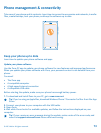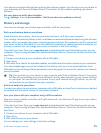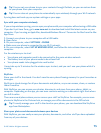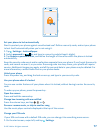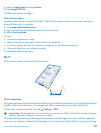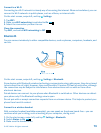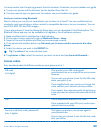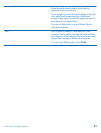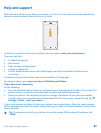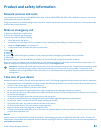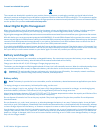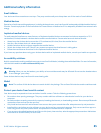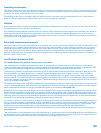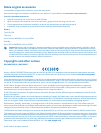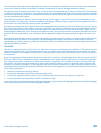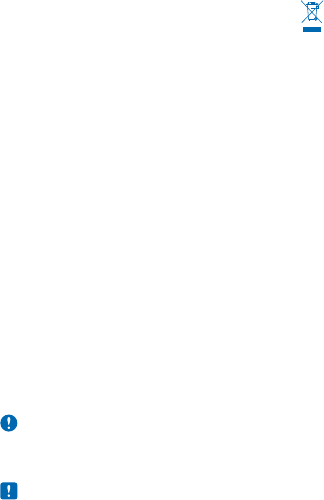
Crossed-out wheeled-bin symbol
The crossed-out wheeled-bin symbol on your product, battery, literature, or packaging reminds you that all electrical and
electronic products and batteries must be taken to separate collection at the end of their working life. This requirement applies
in the European Union and Turkey. Do not dispose of these products as unsorted municipal waste. For more environmental info,
see the product Eco profile at www.nokia.com/ecoprofile.
About Digital Rights Management
When using this device, obey all laws and respect local customs, privacy and legitimate rights of others, including copyrights.
Copyright protection may prevent you from copying, modifying, or transferring photos, music, and other content.
Digital rights management (DRM) protected content comes with an associated licence that defines your rights to use the content.
With this device you can access content protected with WMDRM 10. If certain DRM software fails to protect the content, content
owners may ask that such DRM software's ability to access new DRM-protected content be revoked. Revocation may also prevent
renewal of such DRM-protected content already in your device. Revocation of such DRM software does not affect the use of
content protected with other types of DRM or the use of non-DRM-protected content.
If your device has WMDRM-protected content, both the licences and the content are lost if the device memory is formatted. You
may also lose the licences and the content if the files on your device become corrupted. Losing the licences or the content may
limit your ability to use the same content on your device again. For more info, contact your service provider.
Battery and charger info
Your device has an internal, non-removable, rechargeable battery. Do not attempt to remove the battery, as you may damage
the device. To replace the battery, take the device to the nearest authorised service facility.
Charge your device with AC-16, AC-50 charger. Charger plug type may vary.
The battery can be charged and discharged hundreds of times, but it will eventually wear out. When the talk and standby times
are noticeably shorter than normal, to replace the battery, take the device to the nearest authorised service facility.
Important: Talk and standby times are estimates only. Actual times are affected by, for example, network conditions,
device settings, features being used, battery condition, and temperature.
Battery safety
Note: The battery in your device is non-removable, so refer to the battery-related statements as applicable to your device.
To unplug a charger or an accessory, hold and pull the plug, not the cord.
When your charger is not in use, unplug it. Do not leave a fully charged battery connected to a charger, as overcharging may
shorten the battery’s lifetime. If left unused, a fully charged battery will lose its charge over time.
Always keep the battery between 15°C and 25°C (59°F and 77°F). Extreme temperatures reduce the capacity and lifetime of the
battery. A device with a hot or cold battery may not work temporarily.
Do not dispose of batteries in a fire as they may explode. Obey local regulations. Recycle when possible. Do not dispose as
household waste.
Do not dismantle, cut, crush, bend, puncture, or otherwise damage the battery in any way. If a battery leaks, do not let liquid
touch skin or eyes. If this happens, immediately flush the affected areas with water, or seek medical help. Do not modify, attempt
to insert foreign objects into the battery, or immerse or expose it to water or other liquids. Batteries may explode if damaged.
Use the battery and charger for their intended purposes only. Improper use, or use of unapproved or incompatible batteries or
chargers may present a risk of fire, explosion, or other hazard, and may invalidate any approval or warranty. If you believe the
battery or charger is damaged, take it to a service centre before continuing to use it. Never use a damaged battery or charger.
Only use the charger indoors.
© 2013 Nokia. All rights reserved.
84



